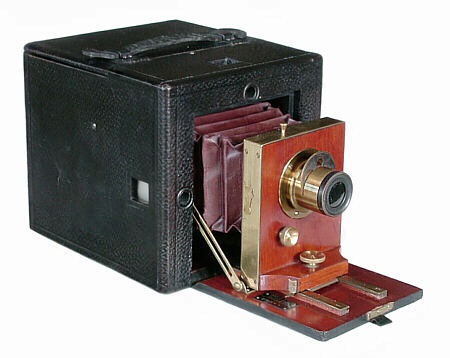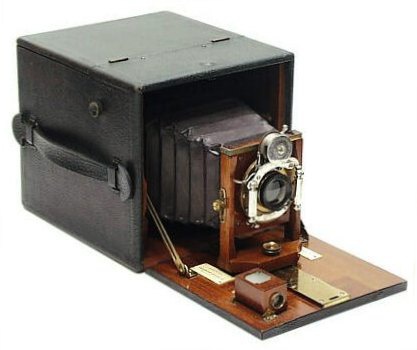|
|




Copyright ©2008 by Rob Niederman - ALL RIGHTS RESERVED
Return to the Self-Casing Cameras page
Following in the footsteps of Eastman Kodak Company and the Scovill & Adams
Company, the Rochester Optical Company introduced its version of a self-casing
camera, the Folding Premier "Hand and Stand" Camera, in 1892.
The Folding Premier mimicks the design approach of its competitors; polished wood interior, red leather bellows, brass hardware, and a black leather covered body that protects all components when closed. It is also one of the few self-casing cameras made by Rochester Optical Company that does not have a "Premo" or "Poco" name.
A shutter built into a polished wood and brass trimmed front standard differentiates the first version from later models and gives it a distinctive look. Early models with the internal shutter are scarce, and sometime after 1892 the camera was redesigned with a more traditional external brass shutter.
Two other cameras, Blair's Folding Hawkeye No.1 and Rochester Camera Mfg. Co's "Rochester," also had concealed shutters.
The Folding Premier mimicks the design approach of its competitors; polished wood interior, red leather bellows, brass hardware, and a black leather covered body that protects all components when closed. It is also one of the few self-casing cameras made by Rochester Optical Company that does not have a "Premo" or "Poco" name.
A shutter built into a polished wood and brass trimmed front standard differentiates the first version from later models and gives it a distinctive look. Early models with the internal shutter are scarce, and sometime after 1892 the camera was redesigned with a more traditional external brass shutter.
Two other cameras, Blair's Folding Hawkeye No.1 and Rochester Camera Mfg. Co's "Rochester," also had concealed shutters.
Multi-Lens Cameras | View Cameras | Self-Casing Cameras | Solid Body Cameras | References & Advertisements
Home | What's New | Show Schedule | Wanted | For Sale | Links | Site Map | Email
Home | What's New | Show Schedule | Wanted | For Sale | Links | Site Map | Email
Advertisements indicate that the first version Folding Premier was offered in 4x5, 5x7 and whole-plate (6½ x 8½) formats. By 1895, only 4x5 and
5x7 sizes of the second version were sold. The 4x5 model was built in two body lengths that could store four or six plateholders. Additionally, all
sizes offered photographers the option to shoot dry plates or rollfilm as well as upgrade to higher grade lenses.
Yet the 1892 Folding Premier has a rare feature not found on any other self-casing camera. Inside the lensboard is a surprisingly sophisticated clockwork shutter capable of shooting six exposures. This feature is also found on the earliest versions of Rochester Optical's Premier box cameras. Although interesting, the multi-shot shutter may not have had much value in day-to-day use. While the shutter can rapidly fire six times after being wound, the photographer still had to change plates or wind film in the rollholder between exposures.
Yet the 1892 Folding Premier has a rare feature not found on any other self-casing camera. Inside the lensboard is a surprisingly sophisticated clockwork shutter capable of shooting six exposures. This feature is also found on the earliest versions of Rochester Optical's Premier box cameras. Although interesting, the multi-shot shutter may not have had much value in day-to-day use. While the shutter can rapidly fire six times after being wound, the photographer still had to change plates or wind film in the rollholder between exposures.
Folding Premier Camera, 1892-97(?)
Rochester Optical Company. Rochester, NY.
Rochester Optical Company. Rochester, NY.
1892 Premier Folding Camera (First Version), 4" x 5"
Format Concealed Clockwork Shutter, 4 x 5 Premier Lens
Format Concealed Clockwork Shutter, 4 x 5 Premier Lens
At the right is an example of the early second version of the Folding Premier
Camera. It retains the top loading plateholder design and the capability to store
four double plateholders inside the body. The second model also included a bed
mounted reflex finder. Later second version models were made with a side
loading body pattern.
A knob on the body side locks the single swing ground glass. Small levers inside body walls provide the swing movements. The front standard includes a rise/fall adjustment.
Comparing the prices of concealed shutter models against later external shutter versions infers that the clockwork shutter may have been an expensive feature with little perceived value. In 1892, a 4x5 concealed shutter Folding Premier sold for $21 (approximately $401 in year 2000 currency), while the 1895 version with external shutter was offered for $18 (about 17% less). This price difference may explain why the multi-shot shutter was sold for only a brief time.
Although the concealed shutter design may have been less successful than anticipated, it is important to note that the Folding Premier camera represented a marketing milestone for the Rochester Optical Company. The company was able to build and sell a high-quality camera at a significantly lower price than similar cameras. Using 1892-93 prices for 5x7 cameras as a point of reference, the first version Folding Premier sold for $28. Competitive models included the No.4 Folding Kodak ($50), Scovill's Henry Clay ($50), Rochester Camera Mfg. Co's "Rochester" ($40), and Blair's Folding Hawkeye No.1 ($40) and No.2 ($60). Rochester Optical's marketing leadership in being able to offer lower priced, high-quality cameras continued throughout the remainder of the 1890s.
A knob on the body side locks the single swing ground glass. Small levers inside body walls provide the swing movements. The front standard includes a rise/fall adjustment.
Comparing the prices of concealed shutter models against later external shutter versions infers that the clockwork shutter may have been an expensive feature with little perceived value. In 1892, a 4x5 concealed shutter Folding Premier sold for $21 (approximately $401 in year 2000 currency), while the 1895 version with external shutter was offered for $18 (about 17% less). This price difference may explain why the multi-shot shutter was sold for only a brief time.
Although the concealed shutter design may have been less successful than anticipated, it is important to note that the Folding Premier camera represented a marketing milestone for the Rochester Optical Company. The company was able to build and sell a high-quality camera at a significantly lower price than similar cameras. Using 1892-93 prices for 5x7 cameras as a point of reference, the first version Folding Premier sold for $28. Competitive models included the No.4 Folding Kodak ($50), Scovill's Henry Clay ($50), Rochester Camera Mfg. Co's "Rochester" ($40), and Blair's Folding Hawkeye No.1 ($40) and No.2 ($60). Rochester Optical's marketing leadership in being able to offer lower priced, high-quality cameras continued throughout the remainder of the 1890s.
1894 Folding Premier Camera.
(Second Version), 4" x 5" Format.
Victor Diaphragm Shutter / RR Lens.
(Second Version), 4" x 5" Format.
Victor Diaphragm Shutter / RR Lens.